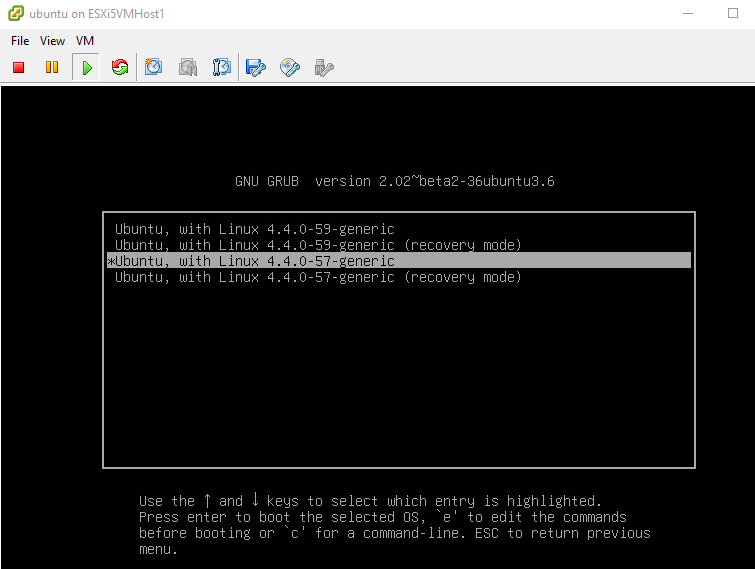To begin, it will probably take at least 30 minutes resolve this issue…
This fix solved my problem with the “vfs unable to mount root fs” error, but of course your results may vary. As always, first backup your system or do an export of the vm so you have a copy of the system as it existed before you started screwing around with it 😉
After running apt-get update / apt-get upgrade and then a reboot, you may receive the following error: kernel panic not syncing vfs unable to mount root fs on unknown-block 0 0 on ubuntu 16.04.
In many cases this will be due to the /boot drive becoming 100% full because many updates have been made to the kernel. By default, ubuntu will retain the old kernels and add them to the list of available kernels you can boot into in the Grub2 boot loader menu. You can confirm that your drive is full by issueing the command:
df -h
The result will likely show the following:
In order to resolve this issue and boot successfully, while you’re looking at the error during boot, (you should already be at the console), and restart the vm or computer into the Grub2 menu then choose “Advanced options for ubuntu” view where you can see a list of old kernels you can boot into. Some report you can do this booting with the Shift key held down, or in the event it’s a virtual machine, you should be able to arrow-down in the Grub start screen and choose Advanced options for ubuntu on startup:
Grub2 boot menu.
Once you go into the advanced boot menu you will likely see several kernels listed. Choose the next-oldest kernel from the top/highest version of kernels. In my case I booted into the version labeled Ubuntu, with Linux 4.4.0-57-generic (my boot menu screenshot below is clean, but you’ll likely see several kernels listed).
Cross your fingers and hope you get to your login prompt. From here I jumped on putty and connected from that client, as I prefer it over the console.
Next, login and follow the directions that I found here:
http://askubuntu.com/questions/2793/how-do-i-remove-old-kernel-versions-to-clean-up-the-boot-menu
To save you the search, here are the instructions I used to first list and then remove the old kernels:
Open terminal and check your current kernel:
uname -a
DO NOT REMOVE THIS KERNEL! Make a note of the version in notepad or something.
Next, type the command below to view/list all installed kernels on your system.
dpkg --list | grep linux-image
Find all the kernels that are lower than your current kernel version. When you know which kernel to remove, continue below to remove it. Run the commands below to remove the kernel you selected.
sudo apt-get purge linux-image-x.x.x.x-generic
Or:
sudo apt-get purge linux-image-extra-x.x.x-xx-generic
Finally, run the commands below to update grub2
sudo update-grub2
Reboot your system.
sudo reboot
As you can see from my terminal history, I had to remove a few:
589 uname -a 590 dpkg --list | grep linux-image 591 sudo apt-get purge linux-image-4.4.0-21-generic 592 sudo apt-get purge linux-image-4.4.0-22-generic 593 sudo apt-get purge linux-image-4.4.0-24-generic 594 df -h 595 sudo apt-get purge linux-image-4.4.0-24-generic 596 sudo apt-get purge linux-image-4.4.0-28-generic 597 sudo apt-get purge linux-image-4.4.0-31-generic 598 sudo apt-get purge linux-image-4.4.0-34-generic 599 sudo apt-get purge linux-image-4.4.0-36-generic 600 sudo apt-get purge linux-image-4.4.0-38-generic 601 df -h 602 sudo apt-get purge linux-image-4.4.0-42-generic 603 sudo apt-get purge linux-image-4.4.0-45-generic 604 sudo apt-get purge linux-image-4.4.0-47-generic 605 sudo apt-get purge linux-image-4.4.0-51-generic 606 sudo apt-get purge linux-image-4.4.0-53-generic 607 sudo update-grub2 608 dpkg --list | grep linux-image 609 df -h 610 sudo apt-get purge linux-image-extra-4.4.0-21-generic 611 sudo apt-get purge linux-image-extra-4.4.0-22-generic 612 sudo apt-get purge linux-image-extra-4.4.0-24-generic 613 sudo apt-get purge linux-image-extra-4.4.0-28-generic 614 sudo apt-get purge linux-image-extra-4.4.0-31-generic 615 sudo update-grub2 616 df -h 617 sudo reboot 618 dpkg --list | grep linux-image 619 uname -a 620 sudo reboot
After the reboot, you can see my /boot partition returned to a manageable size:
I hope this post helps someone save some time and help them fix their ubuntu boot problems. Please leave a comment if this helped resolve your issue or if there is a smarter/faster way to fix this problem.





